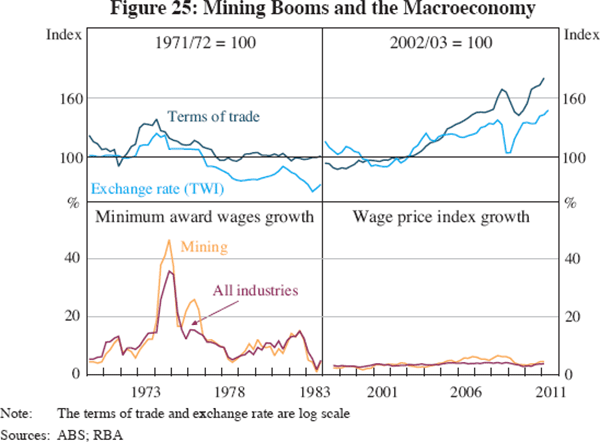RDP 2011-08: The Mining Industry: From Bust to Boom 5. Comparisons with Past Mining Booms
December 2011
- Download the Paper 1.02MB
Mining booms are not new to Australia. Focusing on the post-WWII period, there were a number of booms between the late 1960s and the early 1980s, due to new discoveries and surges in global commodity prices. In the late 1960s, increased Japanese demand for steelmaking materials and the development of bulk carriers opened up the seaborne trade in coal and iron ore, and there were discoveries of oil, bauxite and nickel. This resulted in a surge in mining investment and culminated in the Poseidon stock market bubble in 1969/70. Then in 1973 and 1974, energy prices increased dramatically due to the OPEC oil embargo, while mineral commodity prices also rose strongly, resulting in a 30 per cent increase in Australia's terms of trade before they fell back as the world entered recession in 1974/75. The second surge in commodity prices from 1978 to 1981 led to another period of great optimism, with expectations that Australia would become a much larger exporter of energy and processed metals. However, this turned out to be short-lived – although commodity prices rose by 40 per cent over the period, import prices were also rising strongly, largely offsetting the boost to national income, and commodity prices subsequently began their long decline with the 1982 global recession.[27] These booms were associated with periods of very poor macroeconomic outcomes, with high unemployment and inflation. In comparison, although Australia has experienced a larger mining boom in the 2000s, the macroeconomy has been much more stable, partly due to improvements in the institutional framework with the adoption of a floating exchange rate, decentralised wage bargaining, an inflation-targeting regime and product market flexibility.
Australia's freely floating exchange rate has allowed a real appreciation to occur in response to the 2000s mining boom without the adjustment coming through high inflation, as occurred under the less flexible exchange rate regimes of the 1970s and early 1980s. The surge in mining export receipts in the late 1960s and early 1970s generated strong domestic demand and placed upward pressure on the exchange rate. The Government kept the exchange rate fixed, building foreign reserves and allowing the domestic money supply to grow at an annual rate of over 20 per cent in the early 1970s (Figure 25). When the Government finally revalued the exchange rate in late 1972 and 1973, it was too late to restrain inflation, which had drifted up from around 3 per cent in the late 1960s to 7 per cent in 1971. In contrast, during the 2000s, the floating exchange rate began appreciating as the global economy recovered from the 2001 recession, and appreciated further over the remainder of the decade as the terms of trade continued to rise. Furthermore, when commodity prices moved sharply in 2008/09, the exchange rate adjusted to cushion the shock to the economy. Overall, the higher exchange rate has helped to offset the expansionary effect of the increase in mining export receipts and investment.

The consequences of the mining booms in the 1970s and early 1980s for inflation were magnified by the wage-fixing system, which tended to transmit demand pressures in one sector to wages across the economy through the principle of comparative wage justice. In early 1974, at the height of the terms of trade boom, miners secured a 20 per cent increase in minimum award wages, which was followed soon after by a similar increase in award wages for all industries. When combined with the surge in energy prices, the wages explosion resulted in inflation peaking at over 17 per cent in early 1975. This episode significantly increased real wages across the economy, contributing to a structural increase in unemployment over subsequent years. The (short-lived) resources boom of the early 1980s led the metals manufacturing industry to agree to a 24 per cent rise in hourly wages in 1982, which then set a precedent for other industries, resulting in a 16 per cent rise in wages across the workforce (Kelly 1992). This explosion in wages was followed by inflation of over 12 per cent and the 1982/83 recession, during which employment in metals manufacturing fell by a fifth and the unemployment rate rose to 10 per cent. In contrast, the replacement of the centralised wage system with more deregulated wage structures has enabled a rise in mining industry wages in the 2000s to be contained from the wage structure across the economy.
Other changes in government policy have also contributed to better macroeconomic outcomes during the 2000s. The current boom has occurred after a strengthening of institutions, including the introduction of a clear inflation-targeting framework and operational independence for the RBA, with inflation and aggregate wage growth remaining much more contained during the 2000s than in the 1970s and early 1980s. In addition, the economic reforms undertaken by Australian Governments since the 1970s to deregulate product markets have improved the ability of the economy to flexibly respond to mining booms and changes in relative prices more broadly. As an example, trade barriers have been wound back progressively, with the Productivity Commission (2011) estimating that the effective rate of assistance to manufacturing has fallen from around 35 per cent in the early 1970s to around 5 per cent in the 2000s. The lower trade barriers have given households and businesses greater access to global markets to satisfy the extra demand generated by the mining boom, reducing the inflationary pressure in the domestic economy.
Footnote
For more detail on these mining booms, see Sykes (1978), Pagan (1987), Blainey (2003), Gruen (2006) and Battellino (2010). [27]